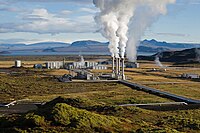
Photo from wikipedia
Abstract Understanding the flow and heat transfer in fractured geothermal reservoir is critical for the development of enhanced geothermal system (EGS) in the future. Under the framework of discrete fracture… Click to show full abstract
Abstract Understanding the flow and heat transfer in fractured geothermal reservoir is critical for the development of enhanced geothermal system (EGS) in the future. Under the framework of discrete fracture network, a thermal-hydraulic coupled model is proposed to evaluate the heat extraction performance of multilateral wells in fractured reservoirs. Five cases with varying numbers of branch wells considering well orientation are compared. In addition, we analyze the heat extraction performance response of multilateral wells in fractured reservoirs to the operating parameters. Results demonstrate the minimal effect of the increasing number of branch wells on the production temperature, while impacts on the well pressure are much greater. The injection pressure is observed to decrease significantly as the number of branch wells increases, resulting in a reduced reservoir flow resistance and increased net thermal energy by reducing pump energy consumption. For the same case, increasing the number of intersections between wells and fractures reduces the production temperature and injection pressure. Parameter sensitivity analysis reveals heat production to increases with the mass flow rate, well length and well spacing, and decreases with increasing fracture permeability. This study is expected to provide a view for the application of multilateral wells in fractured geothermal reservoirs.
Journal Title: Renewable Energy
Year Published: 2021
Link to full text (if available)
Share on Social Media: Sign Up to like & get
recommendations!